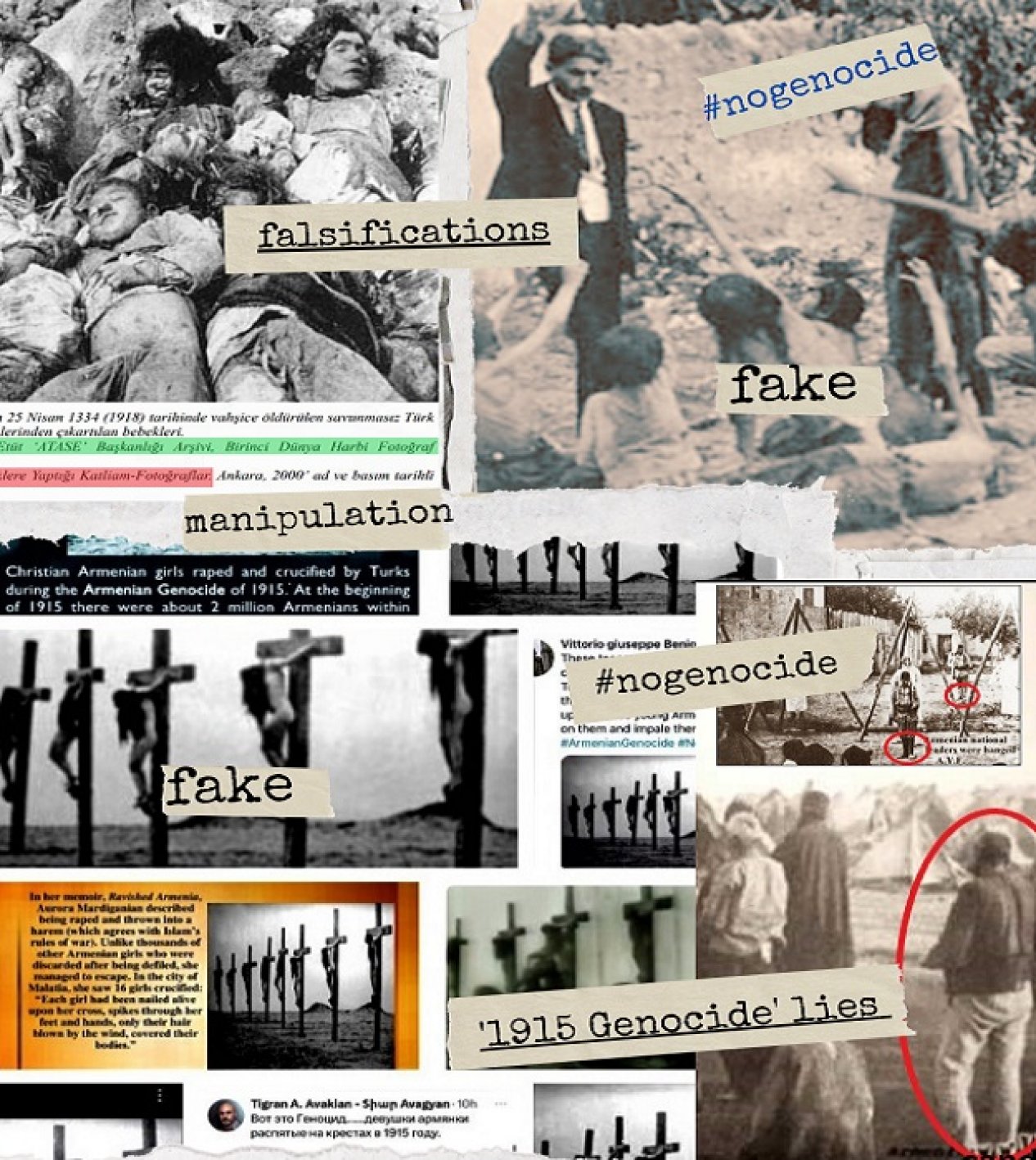
Over the past 100 years, the Armenian lobby has employed various means to spread false "genocide" claims, including altering historical documents and misappropriating photos and videos from other nations, attributing them to their own.
Faktyoxla Lab has conducted research on the photos and videos that Armenians have consistently used, based on open sources.
The photos most frequently referenced in the Armenian lobby's fabricated genocide campaign are those taken by German national Armin T. Wegner in 1915-1916.
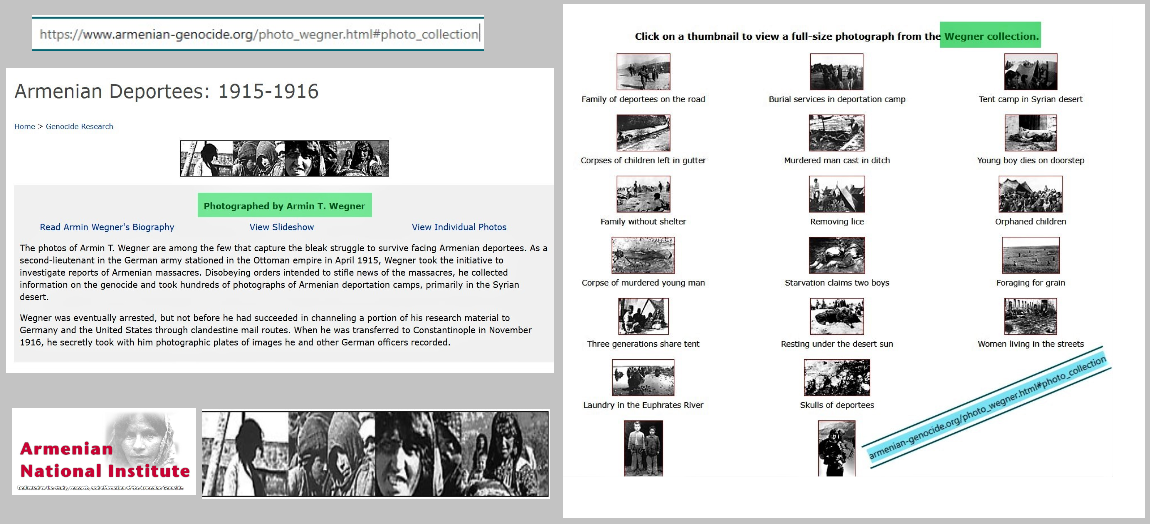
Sources indicate that Wegner, who served as a second lieutenant in the German army, was sent to the Middle East as an officer attached to the German Health Corps, where he began his activities in August 1915.
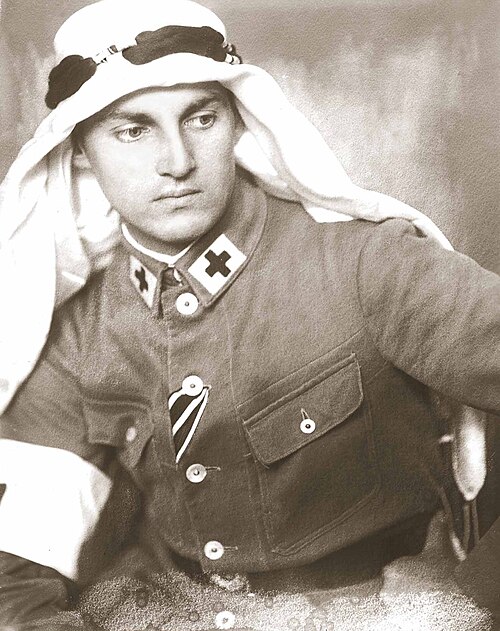
Wegner was tasked with investigating the alleged Armenian massacre that supposedly occurred in April 1915. In the fall of that year, he traveled to various parts of Anatolia, where he collected articles, letters, and documents from the Armenian deportation camps and took hundreds of photographs. He then sent these materials to Germany and the United States. The photos he took, which are claimed to be from that period, continue to be used by the Armenian lobby as evidence of the so-called "genocide" to this day.
After extensive research, Associate Professor Dr. Savaş Eğilmez, Vice President of the "Association for the Struggle Against Groundless Genocide Claims" (ASİMED) at Atatürk University, had claimed that those archive photos were fake.
Eğilmez stated that the photos are claimed to have been taken in 1915–1916 by Armin T. Wegner, a German national. “First of all, the fact that this individual, an officer in the German army, could simultaneously serve in the military and travel so freely across a region beyond his official duties is questionable in itself.” He added: “Over the course of 18 months, Wegner reportedly served as an officer, traveled to Syria and Anatolia, visited Armenian deportation camps where he took photographs, heard accounts from various individuals, was detained, contracted cholera, and eventually arrived in Istanbul.”
Referring to the 18-month period Wegner spent in Anatolia in 1915 and 1916, Eğilmez said:
“During this period, aside from the places he claimed to have visited, Wegner is said to have traveled approximately 10,000 kilometers directly—a distance that would be exhausting and difficult even with today’s roads and modes of transportation. According to these accounts, he was at times conducting observations in various parts of Anatolia, then suddenly appearing in Syria, spending time in Baghdad, and eventually stopping in Istanbul. It is also worth noting that Wegner was reportedly arrested and detained at times, and even contracted cholera. He is said to have endured numerous extraordinary circumstances solely to document the alleged Armenian genocide. As claimed by the diaspora, he managed to take hundreds of photographs, collect numerous documents, and secretly send them to the United States and Germany. However, the so-called “genocide” documents that the lobby has tirelessly promoted consist of only 15-20 photographs and approximately 20-25 narratives. We will not delve into the stories - referred to as documents - that Wegner allegedly smuggled out of Anatolia, as anyone could fabricate dozens of such accounts. Instead, our focus is on the photographs.
The most striking aspect of these photos is that nearly all of them share the same caption: “Date: 1915, Location: Ottoman Empire, Syrian region.”

In other words, neither the exact date nor the precise location is specified. Wegner himself was uncertain about when and where the photos were taken. Another issue with these photos is the difficulty in determining the ethnic background of the individuals depicted. Those presented as Armenians could just as easily be Turks.
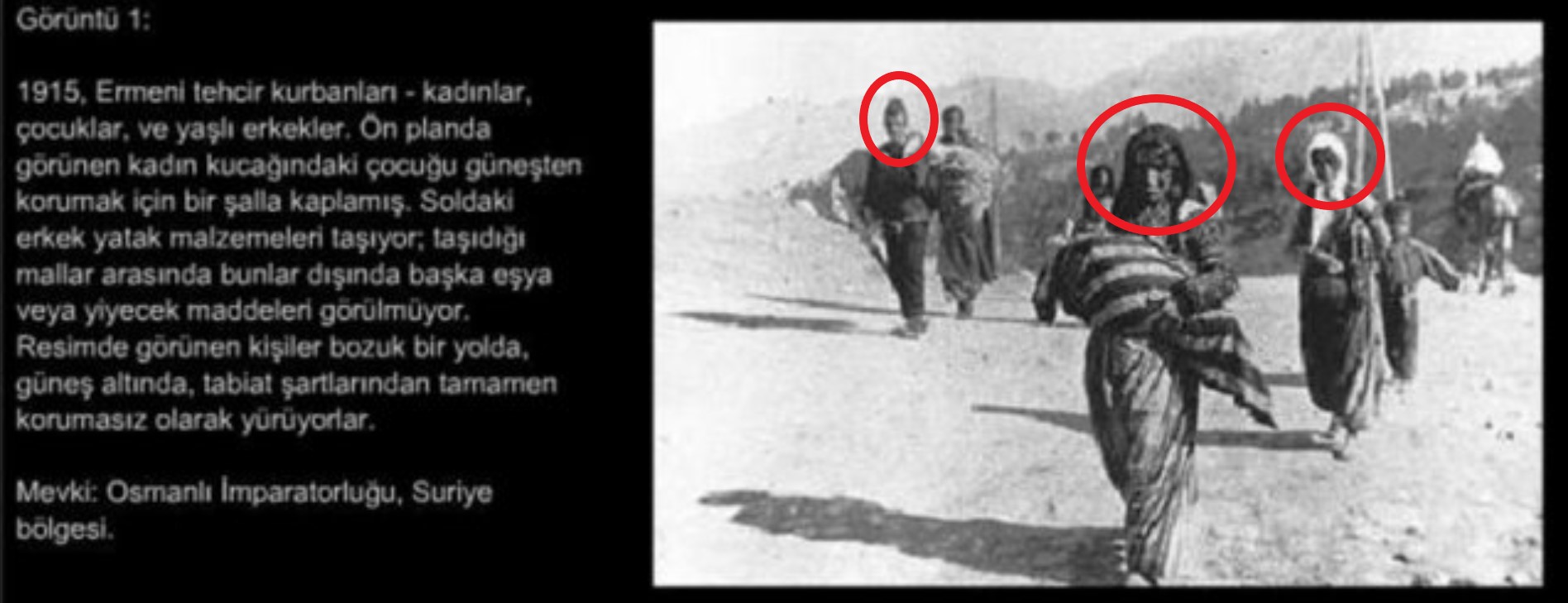
What’s even more intriguing is that some of the photos circulated across all communication channels of the Armenian lobby are also presented under the title "Jewish Holocaust." Furthermore, two of these photos are identical to images found in Russian archives, depicting Turks who were forced to leave Trabzon due to the Russian occupation.

So, either the Jewish sources and Russian archives are lying, or Wegner is. According to our analysis, during the 1915 - 1916 period, when epidemics were rampant, Wegner - who was mentally affected by the cholera he contracted - was likely unaware of whose photos he was taking or where they were taken. As is often the case, the diaspora seized the opportunity and did not hesitate to use these photos,” he said.
The Turkish researcher stated, "Only individuals with the ethics typical of the Armenian diaspora could demonstrate the immorality of accusing an entire nation based on three or five pictures, the true nature of which remains completely unclear." (source)
Fraud 1: In 2014, an article titled "Mehmet Fidan Unveiled the Mask of the Photo" was published by the media outlet "Turkishnews.com". Written under the signature of Aylin D.M., the article notes that many Armenian users on Facebook shared a photo and misled public opinion with false claims, stating, "Ottoman officials are torturing starving Armenian children."
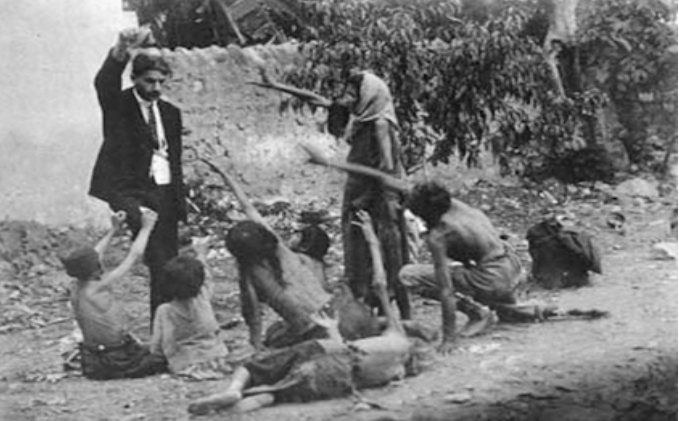
Mehmet Fidan, like any citizen seeking the truth, began to investigate the matter. He stated, "When I searched for this photo online, I was repeatedly confronted with headlines claiming, 'Ottoman officials are torturing starving Armenian children.' It struck me as odd that this was only appearing on pages controlled from the U.S. In any case, regarding the issue I wanted to address, I sent an email to the website where this photo was first published and inquired whether such a photo actually existed."
Below is the screenshot of the original mail he had sent:

It reads:
Hello,
I would like to know if this photo was taken by Armin T. Wegner. There is some news circulating on the internet regarding this photo, with some websites claiming that the person in the image is an Ottoman official torturing starving Armenians.
I look forward to your response.
29.04.2014 Mehmet Fidan
And here is the response to his email:
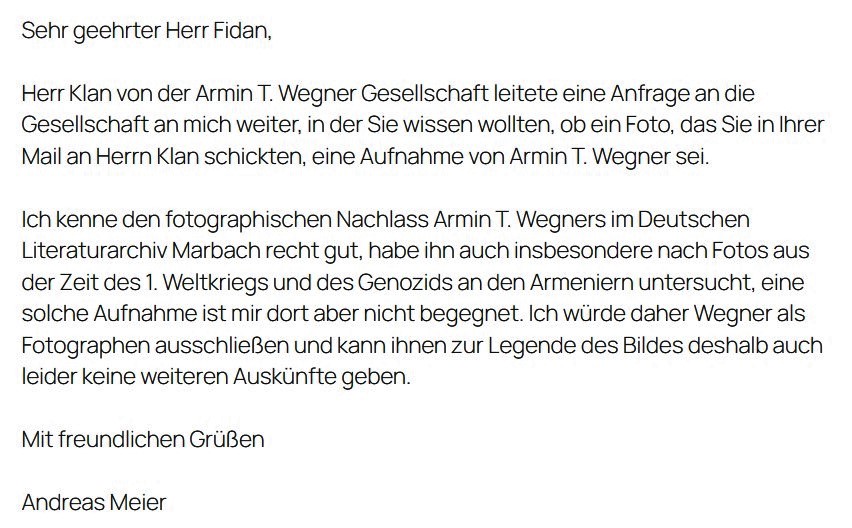
Dear Mr. Fidan,
In your inquiry to the Armin T. Wegner Association, you asked whether the photo in question belongs to Armin T. Wegner. Mr. Klan from the Armin T. Wegner Association has forwarded your question to me.
I am very familiar with the photographic collection of Armin T. Wegner, held at the German Literature Archive in Marbach. I personally searched for photos of the massacres following World War I, but I was unable to find any. Furthermore, I can confirm that Armin T. Wegner did not take this particular photo, and I cannot provide any information on its origin.
Sincerely,
Andreas Meier
In conclusion, the author advises readers not to be deceived by such falsehoods.
Fraud 2: Additionally, Armenian politicians, diplomats, journalists, and social media users frequently share this photo, which is claimed to be linked to the fabricated "Armenian genocide." The photo is titled "Women on the Cross" and is commonly encountered on social media.
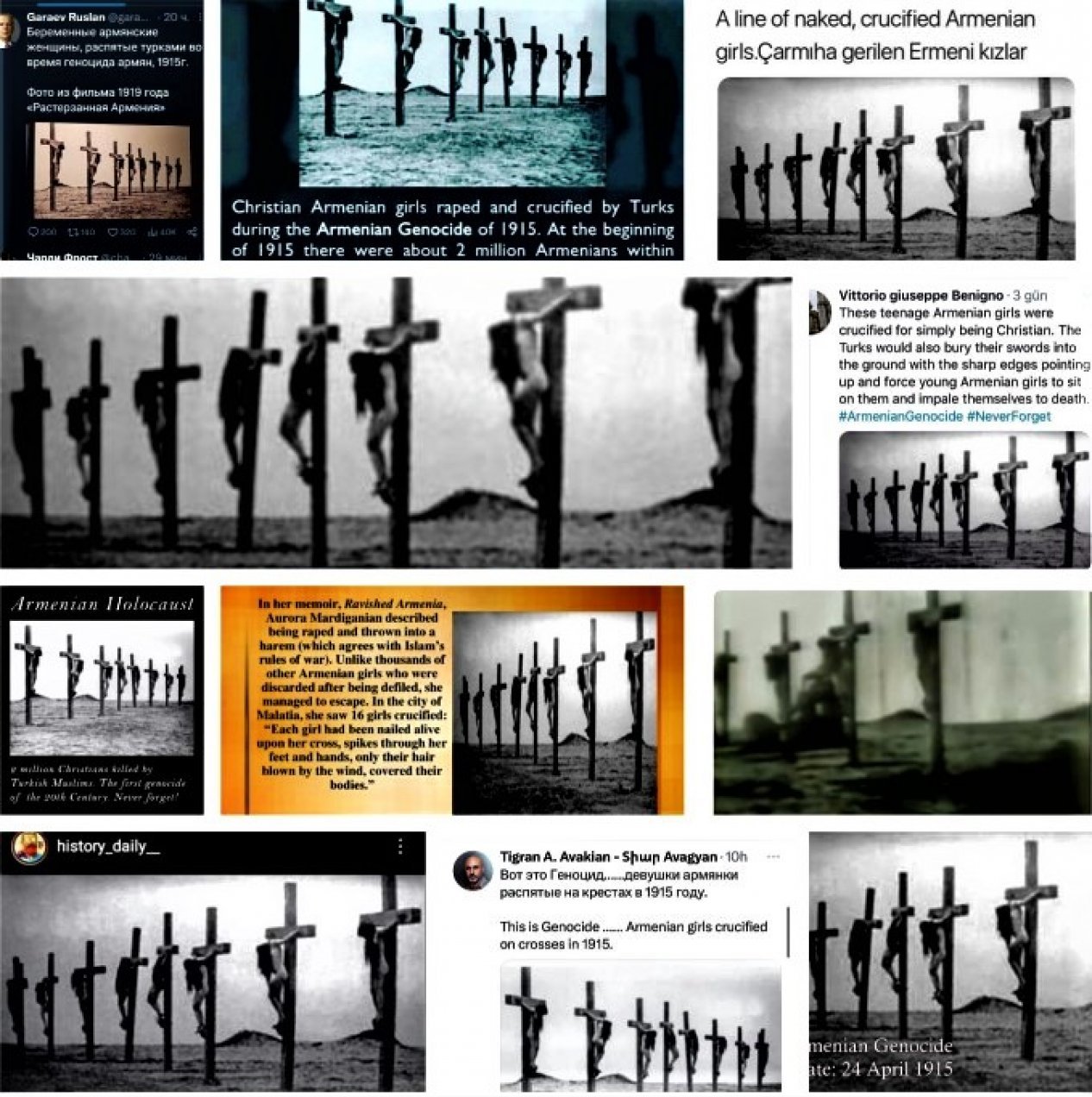
During our research, we discovered that this photo is not original. It was taken from the silent film "Ravished Armenia" (Auction of Souls) honoring fabricated Armenian genocide. The photo is based on the accounts of Arshalyus (Aurora) Mardiganian, who was claimed to be a "witness" to those events.
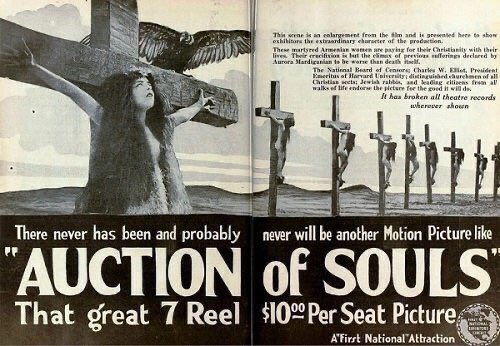
Aurora Mardiganyan, the protagonist of the film "Ravished Armenia" (Auction of Souls), which Armenians present as a symbol of the 1915 events, was born in 1901 in the Dersim region of the Ottoman Empire (present-day Tunceli - editor’s note). During the events of 1915, Mardiganian’s family relocated to Syria.
“Two years later, she escaped from slavery but was recaptured and forced to work again as a slave. Surviving by eating plants and roots, and hiding in forests and caves, she traveled more than 1,500 kilometers over 18 months from the mountains of Dersim to Erzurum, which was under Russian control. Then she reached Tbilisi. From there - assisted by the American Committee for Syrian and Armenian Relief she traveled to Saint Petersburg, and eventually to New York. She was adopted by an Armenian family in New York and wrote about her experiences in newspapers based in New York and Los Angeles.”
As can be inferred from the text, Aurora Mardiganian’s story is far from reality and appears to be more a product of the author’s imagination and screenplay.
In other words, the photo that Armenians present as a symbol of the so-called "genocide" is not authentic - it was taken from a film based on the stories of a girl who claimed to be a witness to the events.
Fraud 3. Another frequently circulated photo, commonly featured across various Armenian sources such as “genocide.ru,” “Yerkramas,” and “Panarmenian,” is often presented as clear evidence of the so-called Armenian genocide.
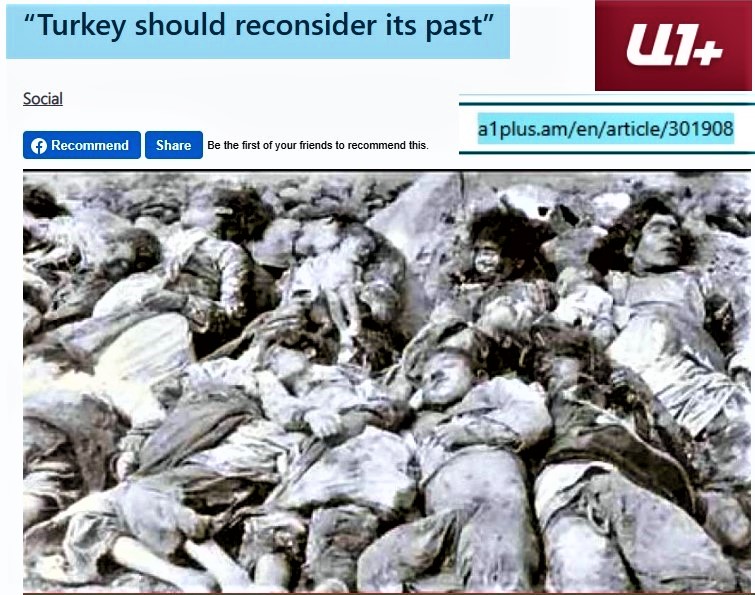
In reality, however, this photo depicts Turkish civilians who were massacred by Armenian armed groups on April 25, 1918, in the village of Subatan, Kars. The image originates from criminal investigation records and is currently preserved in the archives of the Turkish Ministry of National Defense General Staff.
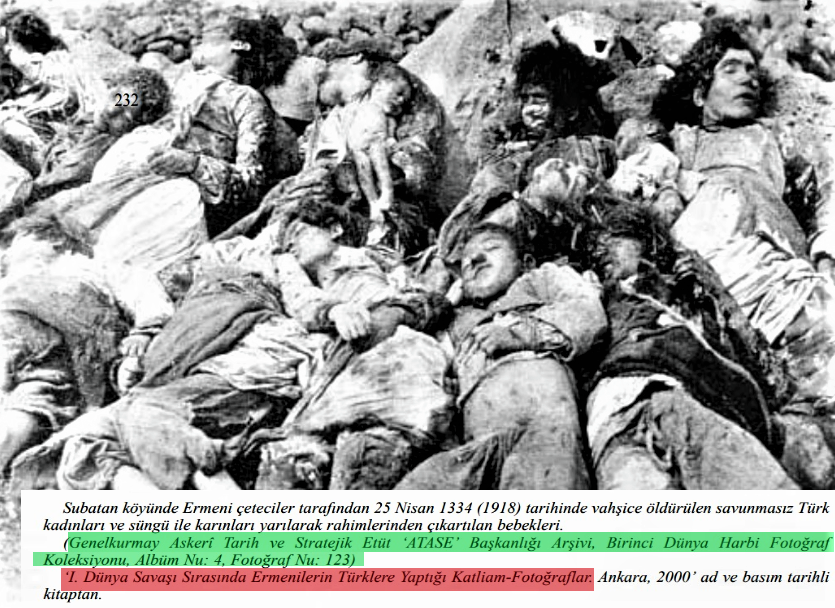
Original caption reads: "Turkish women who were brutally killed without defense by Armenian gangs in the village of Subatan on April 25, 1334 (1918), and babies who were removed from their wombs after their abdomens were slashed with bayonets."
Source: General Staff Military History and Strategic Studies Directorate (ATASE) Archive, First World War Photograph Collection, Album No: 4, Photograph No: 123
Fraud 4. The next photo, frequently used to support Armenian claims, portrays a horrifying scene - one that can easily mislead the average viewer who has not conducted any prior research. When accompanied by false Armenian narratives and fabricated captions, this image fosters a distorted and negative perception of the “Turks,” presenting them as the alleged perpetrators of the depicted event.
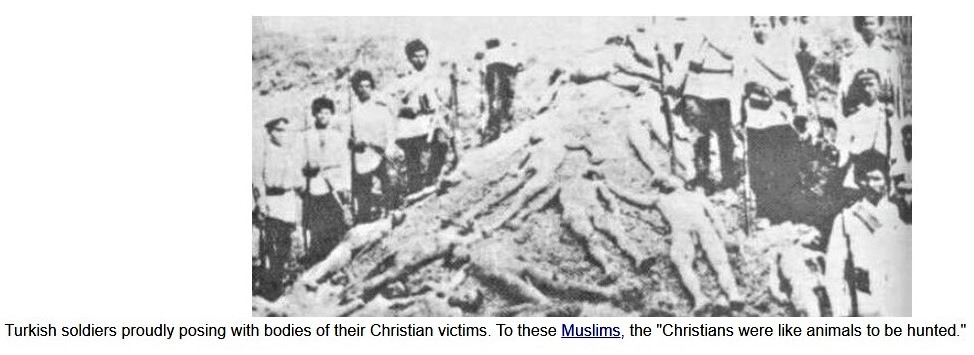
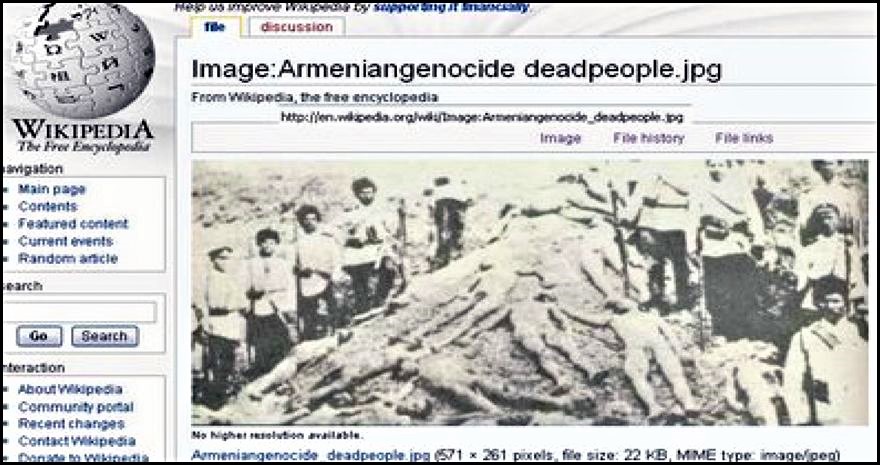
However, this photo and the soldiers depicted in it have no connection to Ottoman Turkey or its Armenian population. The uniformed men shown are Cossack fighters from Russia, taken during the period of the Civil War. (source)
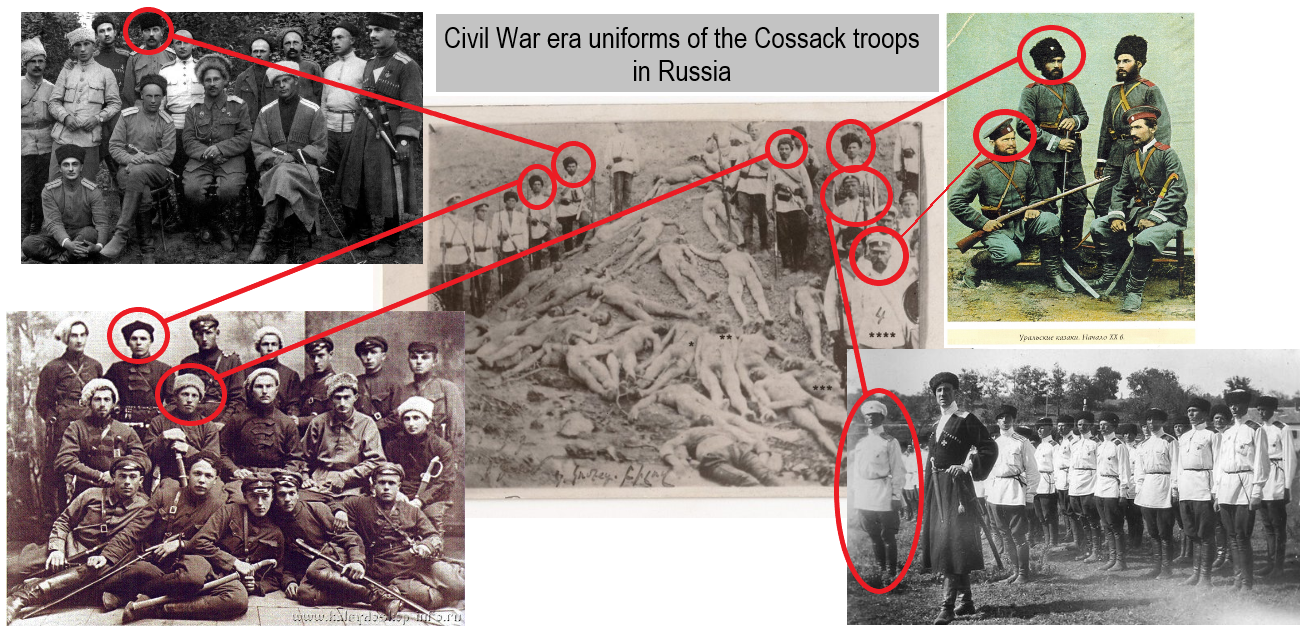
Fraud 5. Let’s examine the photo published on the website genocide.ru under the title “Armenian Women Killed by Turkish Executioners.”
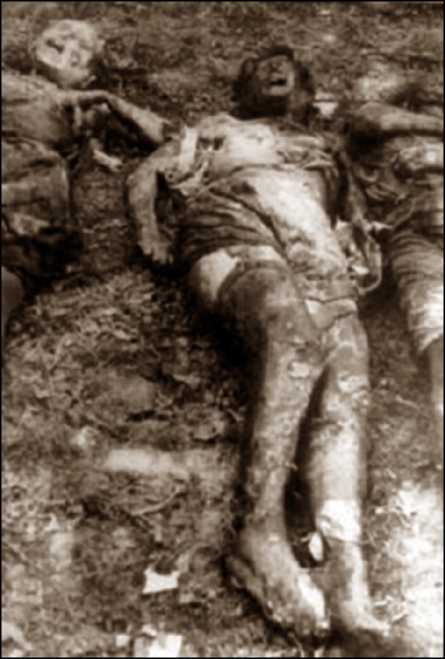
To determine the falsity of this photo, one need only focus on the long stockings worn by the deceased woman. Between 100 and 110 years ago, women in both Asia Minor and Europe did not wear stockings that long. These stockings only became fashionable closer to the time of World War II.
Furthermore, the original of this photo is not stored in Armenia, but in the Holocaust Museum in Israel.
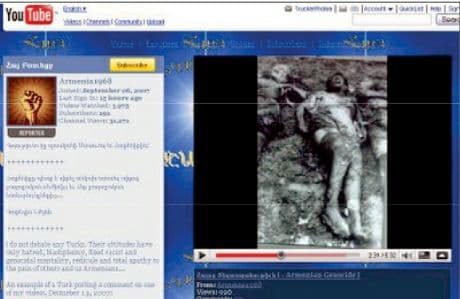
The woman in this photo, taken by the International Red Cross, is not Armenian; she is a Jewish woman who was murdered by nationalists in Hungary during World War II. Interestingly, during that period, the nationalists were led by an ethnic Armenian named Ferenc Szálasi (Salosyan). The group associated with Hitler's favorite partner was called the Arrow Cross Party.
Fraud 6: According to the claim on the website “Hayastan.com,” the photo depicts the “execution of Armenian national leaders.”
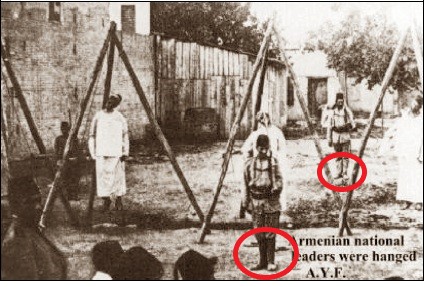
Armenian fabricators have overlooked a small but important detail: Between 1915 and 1918, soldiers of the Turkish Army did not wear long boots, but rather “sarıglı” (a type of cloth-made shoe).
Fraud 8. This is the most prominent example of fabrication used by the authors of the 'Armenian Genocide' narrative.
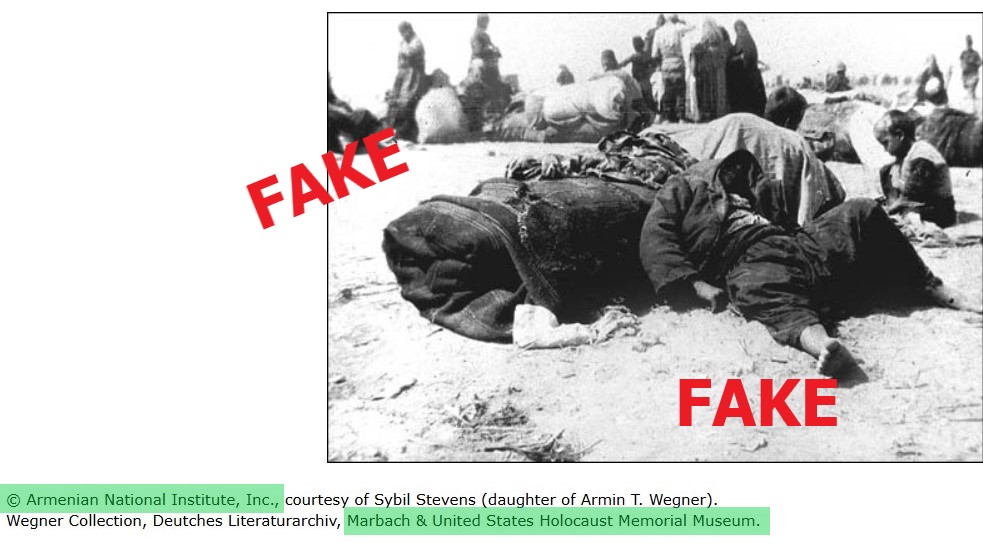
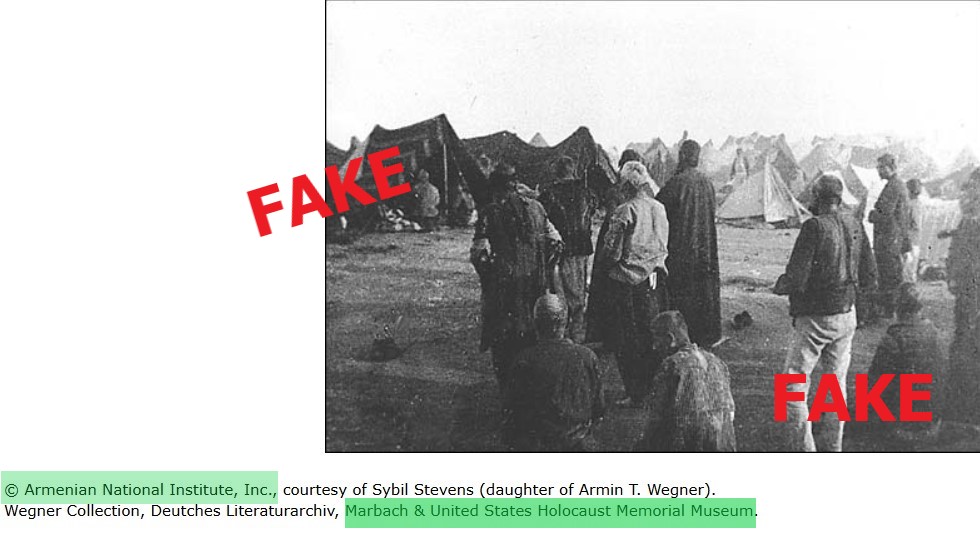
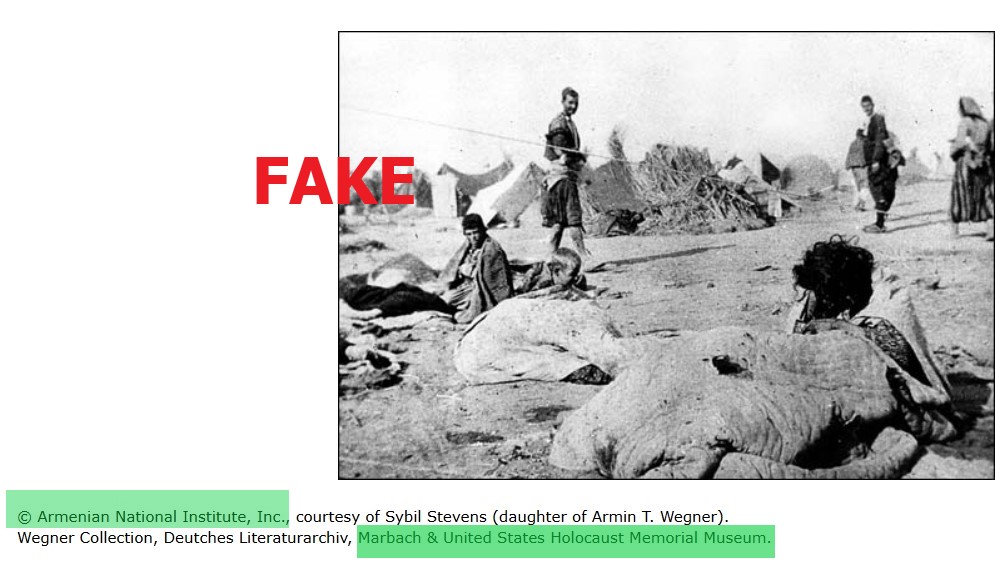
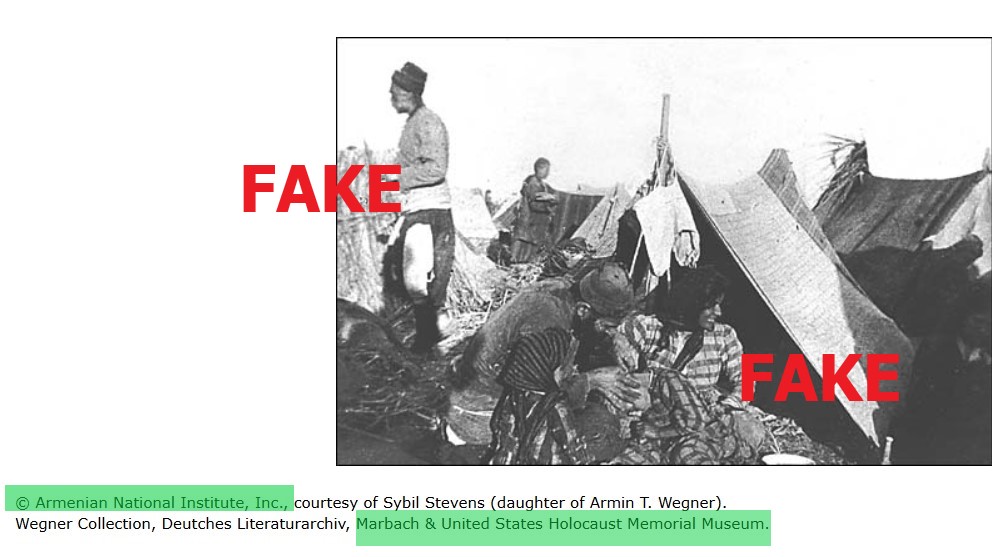
The photos presented as Wegner’s in the 'Armenian Genocide Museum' are actually stills from a film based on Franz Werfel’s novel Forty Days of Musa Dagh. The film portrays the defense of several Armenian villages on Mount Musa, near the Aleppo province in Syria.
The cast of the film included Kabir Bedi, Roni Kurland, Moris Serbani, Viktoriya Vudbek, Michael Konstantin and Peter Haskell. Eventually, stills from the 1982 film were transformed into “historical documents” that supposedly confirm the “genocide”.
In this frame, the person wearing a jacket and jeans - both fashionable for the time - is the film's director, S. Mouradian. He “miraculously” appears in footage from 67 years ago.
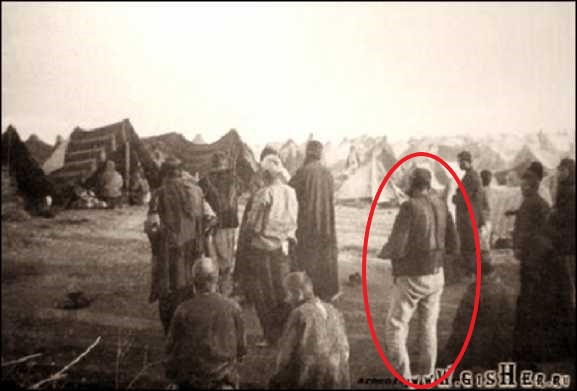
(To be continued)
Conclusion:
- "The photos that Armenians have turned into symbols of the fabricated genocide are mostly falsified - either taken from films or belonging to other nations.
- It is also questionable whether the photos claimed to have been taken by Armin T. Wegner during the alleged 'genocide' actually belong to him."




















